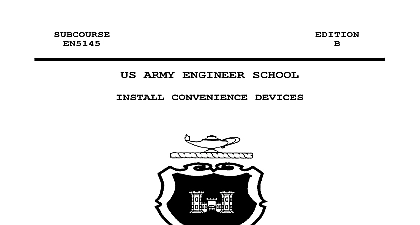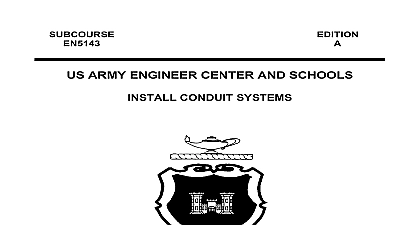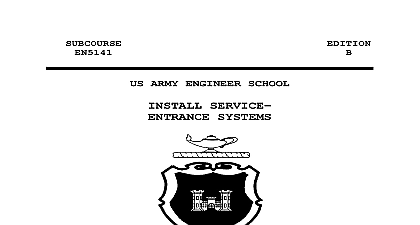INSTALL CIRCUIT PROTECTIVE DEVICES

File Preview
Click below to download for free
Click below to download for free
File Data
| Name | install-circuit-protective-devices-6128759403.pdf |
|---|---|
| Type | |
| Size | 1.23 MB |
| Downloads |
Text Preview
SUBCOURSE ARMY ENGINEER CENTER AND SCHOOL CIRCUIT PROTECTIVE DEVICES CIRCUIT PROTECTIVE DEVICES Number EN5146 B States Army Engineer School Leonard Wood Missouri 65473 Credit Hours Date November 1998 OVERVIEW subcourse is designed to teach the knowledge necessary to perform tasks related to installing fuses circuit and ground fault circuit interrupters GFCIs are no prerequisites for this subcourse subcourse reflects the doctrine which was current at the time it was prepared In your own work situation refer to the latest official publications otherwise stated the masculine gender of singular pronouns is used to refer to both men and women publication contains copyrighted material LEARNING OBJECTIVE will describe the procedures used to install circuit protective devices will be given subcourse booklet EN5146 and an examination response sheet demonstrate competency of this task you must achieve a minimum of 70 on the examination in Figures 1 1 through 1 5 1 8 through 1 10 1 12 through 1 16 and 1 19 through 1 22 is adapted from Wiring Fundamentals by Joseph H Foley This copyrighted material is reproduced with permission McGraw Hill Book Company New York OF CONTENTS Overview i Install Circuit Protective Devices 1 1 A Identifying Circuit Protective Devices 1 2 B Installing Fuses 1 2 C Installing Circuit Breakers 1 7 D Installing Ground Fault Circuit Interrupters 1 9 Exercise 1 13 Key and Feedback 1 15 A List of Common Acronyms A 1 B Recommended Reading List B 1 CIRCUIT PROTECTIVE DEVICES Task 051 246 1107 DESCRIPTION the end of this lesson you will be able to describe the procedures used to install circuit protective devices LEARNING OBJECTIVE the procedures used to install circuit protective devices will be given subcourse booklet EN5146 and an ACCP examination response sheet You work at your own pace and in your own selected environment with no supervision approximately 2 hours you should be able to study the lesson resources and complete practice exercise material contained in this lesson was derived from the following publications 5 51R12 SM TG FM 5 424 and the National Electrical Code NEC available from Fire Protection Association Publications Batterymarch Park Quincy MA 02269 lesson part of the MOS 51R Skill Levels 1 and 2 course is designed to teach the knowledge necessary to tasks related to installing fuses circuit breakers and ground fault circuit interrupters A IDENTIFYING CIRCUIT PROTECTIVE DEVICES protective devices are installed in the circuit to protect it and other equipment in the circuit from an or overload The words overcurrent and overload are used interchangeably but thy have different Overcurrent describes a condition in which a circuit is carrying more than its rated load of amperes Overload describes the starting load of motors and motor driven appliances Motors require heavy flow when starting and much less current at normal running speed order to prevent overcurrent and overload electrical circuits have been designed with built in protective Typical circuit protective devices are fuses circuit breakers and ground fault circuit interrupters Figure 1 1 1 1 Types of circuit protective devices B INSTALLING FUSES become part of the circuit when installed in series with the hot wire of the circuit This is possible because fuse contains a thin metal strip called a fuse element This strip provides protection against overcurrent and The element has a low melting point The size of the element determines how much current it can before heating to the melting point capacity is the ampere rating of the fuse The rated current can flow through the element indefinitely When greater amount of current passes through the element it becomes hot and melts This opens the circuit and a possible fir or other overcurrent damage of Fuses are divided into two general categories plug and cartridge Each category has many types of fuses 1 2 1 2 Types fuses fuses Types of plug fuses that will be discussed in this lesson are standard time delay type S and circuit The standard fuse has an element designed to melt when the current through the fuse its rated amperage Therefore the standard fuse can only be used one time Standard fuses are rated up to 30 amperes Figure 1 3 page 1 4 The time delay fuse is a dual element fuse Figure 1 4 page 1 4 It offers the of a standard fuse for shorted circuits It also provides protection against heating caused by overloads This secondary protection prevents nuisance tripping which is sometimes caused when motor driven appliances such as refrigerators and air conditioners The cutaway of Figure 1 5 1 4 shows both elements of a time delay fuse Note how the fuse responds to shorts and overloads 1 3 Standard fuse 1 4 Time delay fuse 1 5 Cutaway of a time delay fuse The type S fuse has the operating characteristics of a time delay fuse and also the added of being nontamperable The type S fuse is considered nontamperable because the fuse will fit into the base adapter unless it is the correct ampere rating for the circuit Figure 1 6 For example 20 ampere fuse cannot be put into a 15 ampere base The adapter base is designed to stay in place once is inserted into the panel Circuit breaker The circuit breaker fuse is a devise that can be screwed into a fuse panel but it has operating characteristics of a circuit breaker This device can be rest after an overload Figure 1 7 fuses Cartridge fuses are the only type available for circuits rated over 30 amperes Cartridge fuses for 30 to 60 amperes have ferrule contacts Figure 1 8 1 7 Type S fuse and fuse base 1 6 Circuit breaker fuse 1 8 Ferrule contact cartridge fuse Knife blade contact Cartridge fuses for 60 amperes and above have knife blade contacts 1 9 Cartridge fuses with a time delay feature are available at all ampere ratings 1 10 1 9 Knife blade contact cartridge fuse 1 10 Time delay cartridge fuses Fuses Fuses the Element length and diameter of cartridge fuses increase in steps with the ampere rating This limits but does not the possibility of replacing a fuse with one of the wrong size Blown fuses must be replaced with fuses the proper size and ampere value cartridge fuses used in residential wiring provide no visible evidence of being blown as plug fuses usually The only way to tell if a cartridge fuse is blown is to perform a continuity test on it Figure 1 11 blown cartridge fuses can be reused by installing a new fuse element in the fuse cylinder To replace the unscrew the end cape remove the blown element and insert the new element It is important to tighten end cape firmly when the new element is in place Figure 1 12 1 11 Checking a cartridge fuse 1 12 Replaceable element cartridge fuse Spare Fuses are a simple highly reliable and inexpensive way of providing overcurrent protection Fuses have no parts to fail When fuses blow there is often no


